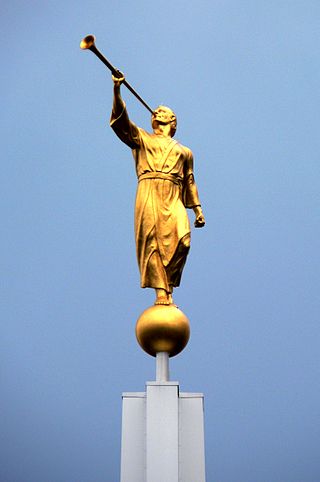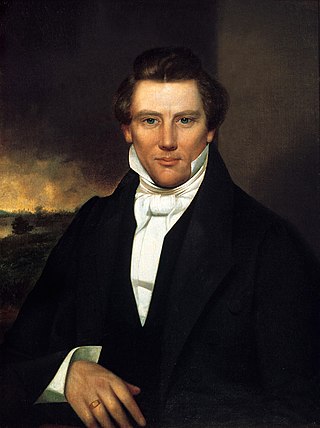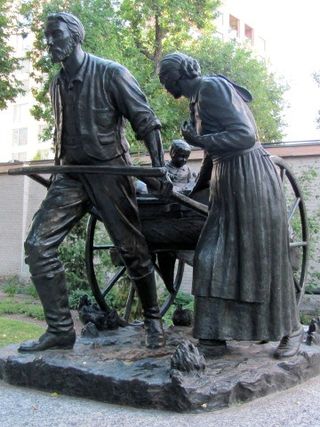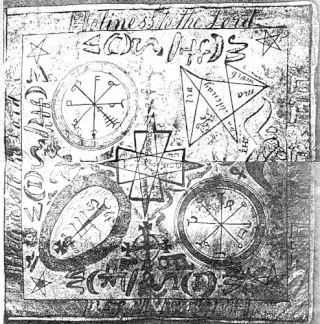
The Book of Mormon is a religious text of the Latter Day Saint movement, first published in 1830 by Joseph Smith as The Book of Mormon: An Account Written by the Hand of Mormon upon Plates Taken from the Plates of Nephi.

Mormonism is the theology and religious tradition of the Latter Day Saint movement of Restorationist Christianity started by Joseph Smith in Western New York in the 1820s and 1830s. As a label, Mormonism has been applied to various aspects of the Latter Day Saint movement, although there has been a recent push from the Church of Jesus Christ of Latter-day Saints to distance themselves from this label. A historian, Sydney E. Ahlstrom, wrote in 1982 that, depending on the context, the term Mormonism could refer to “a sect, a mystery cult, a new religion, a church, a people, a nation, or an American subculture; indeed, at different times and places it is all of these."

The Angel Moroni is an angel whom Joseph Smith, founder of the Latter Day Saint movement, reported as having visited him on numerous occasions, beginning on September 21, 1823. According to Smith, the angel Moroni was the guardian of the golden plates buried near his home in western New York, which Latter Day Saints believe were the source of the Book of Mormon. An important figure in the theology of the Latter Day Saint movement, Moroni is featured prominently in its architecture and art. Besides Smith, the Three Witnesses and several other witnesses also reported that they saw Moroni in visions in 1829.

According to Latter Day Saint belief, the golden plates are the source from which Joseph Smith translated the Book of Mormon, a sacred text of the faith. Some accounts from people who reported handling the plates describe the plates as weighing from 30 to 60 pounds, gold in color, and composed of thin metallic pages engraved with hieroglyphics on both sides and bound with three D-shaped rings.

Oliver H. P. Cowdery was an American religious leader who, with Joseph Smith, was an important participant in the formative period of the Latter Day Saint movement between 1829 and 1836. He was the first baptized Latter Day Saint, one of the Three Witnesses of the Book of Mormon's golden plates, one of the first Latter Day Saint apostles and the Assistant President of the Church.

The Latter Day Saint movement is a religious movement within Christianity that arose during the Second Great Awakening in the early 19th century and that led to the set of doctrines, practices, and cultures called Mormonism, and to the existence of numerous Latter Day Saint churches. Its history is characterized by intense controversy and persecution in reaction to some of the movement's doctrines and practices and their relationship to mainstream Christianity. The purpose of this article is to give an overview of the different groups, beliefs, and denominations that began with the influence of Joseph Smith.

David Whitmer was a leader in the Church of Jesus Christ of Latter Day Saints who eventually became the most interviewed of the Three Witnesses to the Book of Mormon's golden plates.

The Three Witnesses is the collective name for three men connected with the early Latter Day Saint movement who stated that an angel had shown them the golden plates from which Joseph Smith translated the Book of Mormon; they also stated that they had heard God's voice, informing them that the book had been translated by divine power. The Three are part of twelve Book of Mormon witnesses, who also include Smith and the Eight Witnesses.

The "lost 116 pages" were the original manuscript pages of what Joseph Smith, founder of the Latter Day Saint movement, said was the translation of the Book of Lehi, the first portion of the golden plates revealed to him by an angel in 1827. These pages, which had not been copied, were lost by Smith's scribe, Martin Harris, during the summer of 1828 and are presumed to have been destroyed. Smith completed the Book of Mormon without retranslating the Book of Lehi, replacing it with what he said was an abridgment taken from the Plates of Nephi.
Joseph Smith was an American religious leader and the founder of the Latter Day Saint movement whose current followers include members of the Church of Jesus Christ of Latter-day Saints, the Community of Christ, and other Latter Day Saint denominations. The early life of Joseph Smith covers his life from his birth to the end of 1827.

The life of Joseph Smith from 1827 to 1830, when he was 22–25 years old, begins in late 1827, after Smith announced he had obtained a book of golden Plates buried in a hill near his home in Manchester, New York. Because of opposition by former treasure-seeking colleagues who believed they owned a share of the golden plates, Smith prepared to leave the Palmyra area for his wife's home town of Harmony, Pennsylvania. From late 1827 to the end of 1830, Smith would translate the golden plates, publish the Book of Mormon, and establish the Church of Christ.

The Mormon religion is predicated on what are said to be historical events such as the First Vision of Joseph Smith and the historicity of the Book of Mormon, which describes a detailed pre-Columbian history of the Americas. Joseph Fielding Smith, the tenth president of the Church of Jesus Christ of Latter-day Saints, declared that "Mormonism, as it is called, must stand or fall on the story of Joseph Smith. He was either a prophet of God, divinely called, properly appointed and commissioned, or he was one of the biggest frauds this world has ever seen. There is no middle ground." As Jan Shipps has written, "Mormonism, unlike other modern religions, is a faith cast in the form of history," and until after World War II, Mormons did not critically examine the historical underpinnings of their faith; any "profane" investigation of the church's history was perceived "as trespassing on forbidden ground."

In the Latter Day Saint movement, the term Urim and Thummim (;) refers to a descriptive category of instruments used for receiving revelation or translating languages. According to Latter Day Saint theology, the two stones found in the breastplate of Aaron in the Old Testament, the white stone referenced in the Book of Revelation in the New Testament, the two stones bound by silver bows into a set of spectacles (interpreters) that movement founder Joseph Smith said he found buried in the hill Cumorah with the golden plates, and the seer stone found while digging a well used to translate the Book of Mormon are all examples of Urim and Thummim. Latter Day Saint scripture states that the place where God resides is a Urim and Thummim, and the earth itself will one day become sanctified and a Urim and Thummim, and that all adherents who are saved in the highest heaven will receive their own Urim and Thummim.

The Book of Mormon witnesses were a group of contemporaries of Joseph Smith who claimed to have seen the golden plates from which Smith translated the Book of Mormon. The most significant witnesses were the Three Witnesses and the Eight Witnesses, all of whom allowed their names to be used on two separate statements included with the Book of Mormon. Critics have challenged the nature and reliability of the accounts, but church leaders contend that none of the witnesses ever denied what they saw.

Adherents to the Latter Day Saint movement view the Book of Mormon as a work of divinely inspired scripture, which was written by ancient prophets in the ancient Americas. Adherents mostly believe Joseph Smith's account of translating ancient golden plates inscribed by prophets. Smith preached that the angel Moroni, a prophet in the Book of Mormon, directed him in the 1820s to a hill near his home in Palmyra, New York, where the plates were buried. An often repeated and upheld as convincing claim by adherents that the story is true is that besides Smith himself, there were at least 11 witnesses who said they saw the plates in 1829, three that claimed to also have been visited by an angel, and other witnesses who observed Smith dictating parts of the text that eventually became the Book of Mormon.

This is a chronology of Mormonism. In the late 1820s, Joseph Smith, founder of the Latter Day Saint movement, announced that an angel had given him a set of golden plates engraved with a chronicle of ancient American peoples, which he had a unique gift to translate. In 1830, he published the resulting narratives as the Book of Mormon and founded the Church of Christ in western New York, claiming it to be a restoration of early Christianity.

Joseph Smith Jr. was an American religious leader and the founder of Mormonism and the Latter Day Saint movement. Publishing the Book of Mormon at the age of 24, Smith attracted tens of thousands of followers by the time of his death fourteen years later. The religion he founded is followed to the present day by millions of global adherents and several churches, the largest of which is the Church of Jesus Christ of Latter-day Saints.

Cunning folk traditions, sometimes referred to as folk magic, were intertwined with the early culture and practice of the Latter Day Saint movement. These traditions were widespread in unorganized religion in the parts of Europe and America where the Latter Day Saint movement began in the 1820s and 1830s. Practices of the culture included folk healing, folk medicine, folk magic, and divination, remnants of which have been incorporated or rejected to varying degrees into the liturgy, culture, and practice of modern Latter Day Saints.











